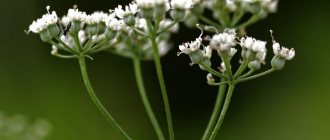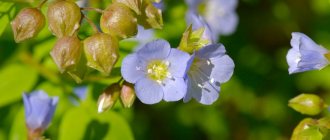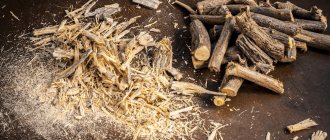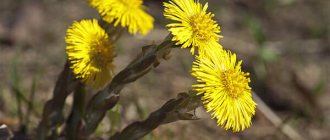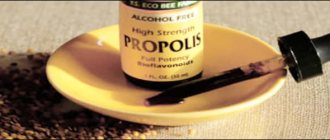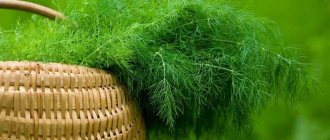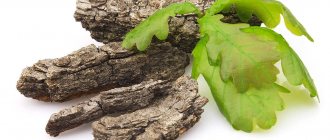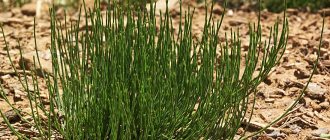How do cough herbs work?
Coughing is a reflex way of clearing the airways of mucus, with the help of which the body tries to get rid of infectious agents and allergens. That is, it is an important protective mechanism that helps speed up recovery.
With a cold or acute respiratory viral infection, an inflammatory process occurs in the upper respiratory tract, where cough receptors are located. As a result, they become irritated. The muscles contract, and with the help of reflex jerky movements of the diaphragm, the body tries to get rid of the pathogenic pathogen. The result is a cough that can be dry or wet. Its type must be taken into account when choosing medicinal plants. {1}
A dry or unproductive cough injures and irritates the mucous membrane, thereby strengthening and supporting itself. It is not accompanied by sputum secretion, and therefore does not clear the respiratory tract of the infectious agent.
Herbs for dry cough should have the following actions:
- antitussive – suppress the cough reflex, which is not physiologically justified;
- enveloping;
- softening;
- anti-inflammatory;
- sedative;
- antimicrobial.
The goal of herbal medicine for dry cough is to stop painful attacks and achieve sputum separation.
A wet, wet or productive cough is accompanied by the release of sputum (mucus), which is produced by the mucous membrane of the respiratory tract. It brings relief, helps remove mucus along with infections and allergens due to the motor activity of the ciliated epithelium and muscle contraction.
Herbs for wet coughs should have the following effect:
- expectorants – promote the removal of mucus from the respiratory tract by increasing mucociliary clearance (natural cleansing) of bronchial secretions;
- mucolytic - dilute sputum, thereby facilitating its removal from the lungs and bronchi;
- anti-inflammatory.
The goal of herbal medicine for wet coughs is to facilitate and accelerate the removal of sputum and reduce its production.
Unlike medications, herbal mucolytics do not cause excessive production of bronchial secretions, therefore they are safe for young children who do not know how to fully cough.
It is known that acute respiratory diseases (ARI) occupy first place among acute infectious pathologies of the respiratory tract (RT) in both children and adults. Acute respiratory infections are a group of polyetiological diseases that arise as a result of the impact on the respiratory tract of various viral and bacterial agents that are tropic to the respiratory epithelium. Among the viruses, respiratory syncytial virus, influenza and parainfluenza viruses, and adenoviruses predominate. Respiratory viruses can cause exacerbations of chronic diseases of the respiratory system, in particular bronchial asthma and chronic obstructive pulmonary disease. It has been proven that damage to the bronchial mucosa by viruses leads to an increase in its permeability to allergens and pollutants, increased production of biologically active substances, which leads to an exacerbation of the disease. Most causative agents of bacterial acute respiratory infections are part of the opportunistic bacterial microflora that constantly resides in the human DP. Therefore, in the mechanism of development of these diseases, the triggering and decisive factor is a sharp decrease in local and general defense factors as a result of exposure to viruses. This clinical situation is observed during the formation of viral-bacterial associations [1].
At the same time, DPs are a complex multifunctional system. The mucous membrane of the respiratory tract is continuously exposed to a variety of potentially pathogenic substances that a person inhales with air. There are many protective mechanisms that determine warming, moisturizing and cleansing the DP from foreign particles. Currently, there are three main cleansing mechanisms for removing inhaled and deposited products in the DP:
- mucociliary clearance (MCC);
- cough – with insufficient effectiveness of MCC;
- alveolar clearance - removal of insoluble particles deposited on the respiratory surface of the lungs.
Mucociliary clearance is the process of cleansing by moving mucus by cilia. The MCC consists of two components: the ciliated apparatus of the ciliated epithelium and the secretory system of the DP, which includes secretory cells, protein-mucosal glands of the submucosal layer and the layer of mucus secreted by them, covering the epithelium of the DP. The fluid lining the inside of the DP consists of two layers: a mucous layer or periciliary fluid (sol), covering the cilia, and a mucin layer (gel), located on top of the sol (see figure). The periciliary fluid, the sol layer, is a low-viscosity solution that allows cilia to vibrate at high frequencies and protects the surface of epithelial cells from overlying mucin. The mucin layer (gel layer) is represented by mucoproteins - high molecular weight glycoproteins produced by goblet cells. The structure of secreted mucins and the chemical nature of their surface groups determine the viscosity and elasticity of bronchial secretions. The chemical composition of the gel layer determines its antimicrobial and antiviral activity due to its constituent secretory immunoglobulins (sIgA), lysozyme, lactoferrin and other biologically active substances.
Disruption of the MCC occurs with any defect in the ciliary or secretory components, which leads to a decrease in the physical, chemical and biological protection of the DP. If the MCC is ineffective, a cough occurs, providing clearing of the respiratory tract [2].
However, it should be borne in mind that cough is a symptom of many diseases. The cough reflex is initiated by stimulation of the sensory nerve endings of the oral cavity, paranasal sinuses, larynx, vocal cords, pharynx, external auditory canal, eustachian tube, trachea and its bifurcation, bronchi, pleura, pericardium, diaphragm, distal esophagus and stomach [ 3].
Based on duration, cough is classified into acute cough lasting up to 3 weeks, chronic cough lasting more than 8 weeks, and protracted cough lasting from 3 to 8 weeks (see table).
Thus, cough is a clinical symptom of many diseases; therefore, determining the cause of cough in order to prescribe etiopathogenetic treatment is often a difficult diagnostic problem.
However, it should be noted that the most common cause of cough is both acute and many chronic diseases of the respiratory system.
The inflammatory response of the mucous membrane of the DP to the influence of viral and bacterial flora leads to the restructuring of the epithelial layer of the mucous membrane. The number of goblet cells increases significantly, the physico-chemical composition of mucus changes, its viscosity increases, which leads to impaired bronchial obstruction. Due to the ineffectiveness of MCC, cough becomes the main mechanism for clearing the respiratory tract.
Violation of the drainage function of the bronchi, the accumulation of viscous bronchial secretions in the airway lead to irritation of the cough receptors of the trachea and bronchi, which determines the development of cough - a complex neuro-reflex mechanism for protecting the airway. The accumulation of tracheobronchial mucus causes ventilation disturbances, and the local immunological protection of the DP is reduced due to a decrease in the concentration of sIgA, lysozyme, lactoferrin and interferon. Increased viscosity of mucus with weakened function of the ciliated epithelium slows down its movement along the DP, which contributes to increased adhesion of pathogenic microorganisms and microbial colonization. This creates a high risk of a protracted course of the inflammatory process.
The choice of medications that affect cough is primarily determined by the causes of its occurrence. Antitussives have a narrow range of use in acute and chronic respiratory diseases as symptomatic therapy. Antitussive drugs (regardless of the mechanism of action) are contraindicated in broncho-obstructive diseases, as well as in cases of hyperproduction of bronchial secretions.
There are two groups of antitussives:
- Central acting agents:
- narcotic type of action (codeine, ethylmorphine hydrochloride);
- non-narcotic drugs (glaucine hydrochloride, butamirate, oxeladin, pentoxyverine).
- Peripheral acting agents (prenoxdiazine, levodopropizine, tipepidine).
The inflammatory process that develops in the airway under the influence of respiratory viruses and bacteria leads to a pronounced disruption of the MCB, an increase in the viscosity of sputum, the development of edema of the mucous membrane and the appearance of the phenomenon of bronchial hyperreactivity, which determines the disturbance in coughing up sputum. In this regard, the use of mucoactive drugs is a priority in the treatment of cough in acute respiratory infections. Their use is based on the ability to influence the thickness of the gel-sol of bronchial secretions, change its viscosity and reduce adhesiveness by increasing the activity of the ciliated epithelium. In accordance with the predominant mechanism of action, mucoactive drugs (MDs) are divided into expectorants (expectants), mucoregulators, mucolytics and mucokinetics [4, 5]. To some extent, the division of mucoactive drugs into groups is arbitrary, determining, first of all, the predominant mechanism of action of drugs for their correct prescription in a specific clinical situation.
Currently, there are a lot of mucoactive drugs that improve coughing up sputum. Some of them have been known for centuries and are classified as herbal medicines, while others have been synthesized and used since the mid-20th century. Combined mucoactive drugs have been created and successfully used, which makes it possible to achieve the desired therapeutic effect while reducing the number and frequency of administration.
There are certain groups of patients (children, pregnant women, nursing and elderly patients) who have contraindications to the administration of synthesized drugs. In the treatment of this category of patients, the prescription of herbal preparations is preferable. At the same time, it is obvious that herbal drugs are not used in the treatment of emergency conditions. They are recommended for acute and exacerbation of chronic diseases of the respiratory system of mild to moderate severity, as well as in combination with other chemotherapeutic agents. In pulmonology, the expectorant, anti-inflammatory and bactericidal properties of medicinal plants are successfully used.
The use of medicinal plants for diseases of DP has a long history. Avicenna, in his Canon of Medicine, written 1012–1024, describes in detail various medicinal plants for the treatment of many diseases. Thus, for pulmonary diseases, Avicenna recommended using plantain seed extract, thyme decoction, infusions of chamomile, fennel, eucalyptus oil and many other medicinal plants. In the 17th century the famous English pharmacist Nicholas Culpener, in his most famous and still cited book, “The Complete Herbalist,” described the therapeutic effect of thyme, the use of a decoction of which contributed to the evacuation of phlegm and easier breathing [6].
Currently, herbal medicines for the treatment of acute inflammatory diseases of the DP are actively used both in Russia and abroad. Thus, in 2014, the results of a study by Y. Du et al. were presented, who interviewed 17,650 children (and their parents) and adolescents in Germany, which confirmed the high frequency of use of herbal medicines in the treatment of acute respiratory infections [7].
Herbal preparations, which include thermopsis, oregano, thyme, wild rosemary, plantain, marshmallow, coltsfoot, are classified as expectorant drugs of reflex action. When used internally, they cause irritation of the stomach receptors, while the secretion of the bronchial glands reflexively increases, the activity of the ciliated epithelium increases, and contractions of the bronchial muscles increase. The sputum becomes less viscous and more abundant, and it is easier to cough up [8].
One of the frequently and effectively used herbal preparations in the treatment of cough in acute respiratory infections is Eucabal syrup and Eucabal balsam (EsparmaGmbH, Germany). The composition of the drug Eucabal syrup contains active ingredients - liquid extracts of plantain and thyme (thyme).
Plantain and thyme have different pharmacological properties, which in combination act synergistically, providing expectorant, secretolytic, anti-inflammatory, moderate bronchospasmolytic effects, causing the high effectiveness of Eucabal syrup for acute bronchitis with productive cough.
Plant mucins contained in plantain extract reduce irritation of the mucous membrane of the trachea and bronchi, which reduces the intensity of dry cough. Phytoncides and phenols of plantain thin bronchial secretions and improve mucociliary transport. It was found that plantain extract contains glycosides (aucubin) and flavonoids, which also determines its antimicrobial, especially against Staphylococcus aureus, anti-inflammatory and expectorant effects [9]. Interesting data obtained in studies by R. Gomez-Flores et al., where the immunomodulatory effect of substances contained in plantain leaf extract was shown, in the form of a decrease in the release of pro-inflammatory cytokines, in particular tumor necrosis factor α [10].
Thyme extract has also been used for many years to treat inflammatory diseases of the duodenum, both as monotherapy and in combination with other medicinal plants. Thyme herb contains about 2.5% essential oil, the main active components of which are the monoterpenoid phenols thymol (30–45%) and carvacrol (3–15%). To this day, research and analysis of the biological properties and mechanism of action of various essential oils continues. At the same time, the antimicrobial effect of thyme essential oil has been proven. Both thyme essential oil and extracted thymol have an antibacterial effect against a number of microorganisms, incl. S. aureus, Escherichia coli, Klebsiella рneumoniae, etc. In addition, phenols are active against antibiotic-resistant microflora, incl. L-forms and fungi [11, 12]. The expectorant and secretolytic effects of thyme essential oil and flavonoids are due to the fermentation of thick viscous secretions and an increase in the mobile activity of the ciliated epithelium. For the most part, the effect depends on the property of the essential oil surfactant to change the colloidal state of sputum. The antispasmodic effect of flavonoids provides moderate bronchodilation and easier breathing [13].
Thus, in Eucabal syrup, the positive effects on DP inherent in the extract of plantain and thyme are summed up, which determines its high effectiveness.
The greatest experience in the use of herbal medicines for acute respiratory infections, in particular Eucabal syrup, has been accumulated in pediatric practice [9, 14]. Eucabal syrup is approved for oral administration to children from 1 year of age. The duration of treatment is determined by the attending physician depending on the severity of the disease. Thus, for mild forms, it is recommended to use drugs for 2 weeks. Data on the clinical use of Eucabal syrup have been published, indicating its high clinical effectiveness in acute bronchitis in children.
All patients showed a decrease in cough pain. Facilitation of coughing was accompanied by a decrease in the adhesive properties of sputum. No side effects were noted when using this drug [14, 15].
At the same time, the use of herbal drugs is also justified for adult patients with acute bronchitis, tracheitis, tracheobronchitis, as well as as part of complex therapy for exacerbation of chronic bronchitis, accompanied by a cough with difficult to separate sputum [16].
In 2012 V.I. Blazhko and Ya.V. Dementieva published the results of a limited clinical study of Eucabal syrup in patients with acute bronchitis [9]. The main symptom of the disease in these patients was a cough with difficult to clear sputum. The study included 40 patients who received outpatient treatment for acute bronchitis. The main group consisted of 20 patients (12 men and 8 women, average age – 36.6±3.6 years). The control group was represented by 20 patients, comparable in gender and age to the patients of the main group. Patients of the main group were prescribed Eucabal syrup 20.0 ml 3 times a day. To assess therapeutic effectiveness, a scoring system was used in relation to patient complaints (cough and its severity; the nature and amount of sputum, shortness of breath and its severity). Complaints of patients, objective parameters of examination of patients were assessed before the start of therapy, on the 1st, 3rd and 7th days of treatment. The adhesiveness of sputum was also studied by the force required to tear off the cover glass from the sputum using a tensometric system - A=F/S (F is the tearing force, S is the area of the cover glass). The effectiveness of cough was assessed by the number of cough impulses required to obtain the first portion of sputum. A clear positive effect of treatment was obtained after 3 days of treatment: in 85% of patients there was a decrease in the severity of cough, in 80% there was a decrease in its pain. After 7 days of treatment, 90% of patients noted the disappearance of pain when coughing along with improved sputum discharge. These clinical improvements were confirmed by the results of an improvement in the adhesive properties of sputum by 2.3 times compared to the start of treatment. All patients completed the study, and Eucabal syrup was well tolerated.
The results of a study conducted on the basis of the State Clinical Hospital named after. S.P. Botkin and State Clinical Hospital named after. E.O. Mukhin in 2021, the results of which confirmed the high effectiveness of Eucabal syrup in the treatment of patients with acute viral rhinosinusitis complicated by tracheobronchitis. Eucabal syrup was used as monotherapy in 34% of patients. On the 5th day of treatment, the effectiveness of monotherapy was assessed as recovery in 75% of patients, improvement in 16.7% of patients, and no effect in 8.3%. As part of complex therapy, which included decongestants and nasal drops based on sea water, recovery was noted in 82.6% of patients, and improvement in 17.4% of patients. The treatment was well tolerated and no side effects were noted [17].
Currently, the possibility of using herbal preparations, in particular Eucabal syrup, in the treatment of the so-called. post-infectious cough [18]. Post-infectious cough is characterized by a protracted course lasting from 3 to 8 weeks and occurs after acute respiratory infections. To determine a cough as post-infectious, a thorough examination of the patient is necessary to exclude complications of an acute respiratory viral infection (ARVI) with the addition of bacterial flora and the development of pneumonia, exacerbation of chronic inflammatory diseases of the respiratory system (chronic bronchitis, bronchial asthma, chronic obstructive pulmonary disease, etc.). The occurrence of post-infectious cough is associated primarily with the persistent violation of the integrity of the ciliated epithelium and the resulting persistent hyperreactivity of the DP [19]. Treatment of post-infectious cough with the use of Eucabal syrup is justified taking into account the wide therapeutic profile of the components included in its composition: plantain and thyme extract, which have the ability to affect the MCC.
The composition of Eucabal balm includes eucalyptus oil 10 g/100 g and pine oil 3 g/100 g. The therapeutic effect of the drug is due to the mutually potentiating effect of its active components. The antimicrobial properties of eucalyptus and pine oils have been known for a long time. Recent decades have been characterized by the emergence of new data confirming the pronounced activity of essential oils against clinically significant respiratory bacteria [13]. Laboratory studies have also shown that a mixture of essential oils of pine, orange, cinnamon, eucalyptus, and rosemary can have an inhibitory effect on influenza viruses [16]. Pine pine oil affects the function of the central nervous system, reduces bronchospasm and facilitates breathing, and due to α-pinene contained in pine needles, it significantly improves microcirculation in the respiratory tract and in the myocardium.
Eucalyptus oil has expectorant, mucolytic and antispasmodic effects, which is due to the active substance 1,8-cineole it contains. The 1,8-cineole contained in eucalyptus oil has been shown to have antimicrobial activity against a variety of bacterial agents, including Mycobactérium tuberculosis, MRSA (Methicillin-resistant Staphylococcus aureus), viruses and fungi (Candida). In recent years, it has also been shown that 1,8-cineole affects the phagocytic activity of leukocytes, significantly increasing it, and is also able to inhibit the release of proinflammatory mediators [20]. U. R. Juergens et al. in 2003 presented the results of a study showing that 1,8-cineole, isolated from eucalyptus oil, has anti-inflammatory and antioxidant properties.
In the case of using 1,8-cineole in complex therapy with budesonide in patients with severe hormone-dependent BA, it was possible to reduce the dose of glucocorticosteroids used [21].
The pharmacotherapeutic effect of essential oils (rarefaction of bronchial secretions, enhancing its evacuation by ciliated epithelium, reducing the severity of catarrhal phenomena in the respiratory tract, as well as antimicrobial action) makes their use in acute respiratory infections advisable [22].
Eucabal balm is used for rubbing, steam inhalation or as a component for preparing medicinal baths. Eucabal is prescribed with caution to patients with various atopic diseases, although the possibility of its use in patients with atopic dermatitis and allergic rhinitis is discussed in the literature [17].
Thus, centuries-old experience in the use of medicinal plants allows us to recommend them in the treatment of acute and chronic diseases of DP. Eucabal, synthesized in two dosage forms (syrup and emulsion), is a highly effective herbal drug that has complex anti-inflammatory, mucolytic, expectorant, antimicrobial, immunomodulatory effects, which allows its use in complex therapy of diseases of the respiratory system. The accumulated experience in using Eucabal confirms its high level of safety, which makes it possible to use it in the treatment of not only adults, but also children.
Indications for the use of cough herbs
Herbal medicine is an aid in the treatment of the following diseases:
- ARVI;
- inflammation of the pharynx, larynx, lower respiratory tract;
- bronchitis;
- pneumonia and other respiratory diseases.
Medicinal plants will also help soothe cough caused by irritation of the mucous membranes with allergens, smoke, dust, too dry air, and foreign bodies.
To get rid of a cough, symptomatic therapy alone is not enough. It is necessary to eliminate the cause, strengthen the immune system in order to prevent the development of chronic respiratory diseases.
How to use medicinal herbs for coughs in children and adults
The main condition is to use the plants for their intended purpose. That is, for a wet cough - expectorant herbs, for a dry cough - antitussives. The most effective are decoctions and infusions; you can also prepare inhalations and tinctures.
In no case should you combine herbs with antitussive and expectorant effects, otherwise you can provoke obstruction - obstruction of the airways, from the pharynx to the bronchioles, with subsequent respiratory failure.
Herbal medicine should be selected by a pediatrician for a child, since plant materials can cause an allergic reaction. Adults who have a cough, especially a prolonged one, also need to consult a doctor. It is necessary to find a cause that may be associated not only with diseases of the respiratory tract, but even of the gastrointestinal tract.
Increased acidity of gastric juice and reflux esophagitis can cause a long, debilitating dry cough in the morning.
Herbal medicines must be taken warm, preferably between meals, up to 3-5 times a day. During therapy, it is imperative to increase the volume of fluid you drink and avoid sour, spicy, or too hot foods, which can irritate the laryngeal mucosa.
Children are prescribed a smaller dose of herbal tea than adults. The dosage of the drug depends on the age of the child:
- under 1 year – 1/2 tsp. 3 times a day;
- 1-3 years – 1 tsp;
- 3-6 years – 2 tsp;
- 6-10 years – 1 tbsp. l. {2}
List of cough herbs
All cough herbs act in two directions: either to suppress the cough center or to clear the respiratory tract of phlegm.
Table 1 – List of cough herbs
| From dry | From wet |
| Eucalyptus, mint, lemon balm, linden blossom, angelica root, chamomile, valerian, motherwort, fir, pine, calamus | Licorice root, calendula, St. John's wort, sage, oregano, plantain, elecampane, coltsfoot, black elderberry flowers, cinquefoil, fennel, lavender, fragrant and tricolor violet, lungwort, thermopsis |
| Marshmallow, ivy, thyme, wild rosemary | |
A child under 1 year old can brew tea from chamomile, licorice root, mint, calendula, oregano and thyme. For older children, coltsfoot, marshmallow, ivy, St. John's wort, thermopsis and others are suitable. {3}
From 3 years old, you can give pharmaceutical Breast collection No. 1, 3 and 4.
Sage, eucalyptus, chamomile, linden flowers are suitable for pregnant women, but only after consultation with a gynecologist.
If you are prone to bronchospasm, you should use lemon balm, oregano, elderberry flowers, chamomile, linden, and valerian root. These same plants are effective for painful non-productive coughing.
What herbs are there for dry cough?
To treat dry cough, coltsfoot, linden, marshmallow root, chamomile, licorice root, thyme and other herbs are used. A dry cough causes itching, hoarseness and discomfort in the throat. Medicinal plants soften it, dilute phlegm and help remove it from the body.
Coltsfoot
This medicinal herb is considered one of the most effective remedies for facilitating breathing and normalizing the functioning of the respiratory tract during colds. Helps with coughs of any nature. Plant:
- has an anti-inflammatory, softening and enveloping effect;
- has a powerful expectorant effect and antipyretic properties;
- removes toxins.
For treatment, decoction, infusion and tea are used. To brew tea, you need to pour boiling water over the dried coltsfoot flowers, let it cool and drink the warm tea in three doses. To make a decoction, the herb is boiled over a fire for 5 minutes, then diluted with warm water and consumed a spoonful several times a day.
Coltsfoot for the treatment of dry cough: Pixabay
Linden flowers
Linden is used as a cough remedy for children and adults. It fights inflammation, reduces fever and the intensity of coughing attacks. It has an expectorant effect and relieves sore throats, helping to quickly get rid of the symptoms of a cold.
Linden tea is used for treatment. Dry linden blossom is poured with boiling water, allowed to brew and cool. Strain and take warm several times a day.
Marshmallow root
Marshmallow is used as an expectorant for children and adults. The plant facilitates the release of phlegm, relieves inflammation, softens a hard cough, envelops and relieves pain, strengthens the immune system. Creates a protective layer on the mucous membranes and prevents their damage. Thanks to this, damaged tissues are quickly restored. Included in many medicines.
Chamomile
Chamomile flowers have an analgesic, anti-inflammatory, antiseptic and antispasmodic effect. They liquefy mucus and speed up its discharge. Associate Professor Diane L. McKay writes that chamomile has:
- moderate antioxidant and antimicrobial activity;
- powerful anti-inflammatory effect;
- some antimutagenic and cholesterol-lowering activity;
- antispasmodic and anxiolytic (reducing anxiety) effect.
Used in the form of tea and decoction for rinsing and inhalation. To brew chamomile tea, pour boiling water over the dried flowers of the plant and leave to steep for 15 minutes. Children are given weak tea, and adults are given more concentrated tea. Can be used to relieve symptoms of smoker's cough.
Uses of Chamomile for Cough: Pixabay
Liquorice root
Licorice root helps get rid of dry cough. One of the most popular remedies with expectorant, anti-inflammatory and emollient properties. This is a complete medicine that can be taken by both children and adults. Licorice root syrup helps in the treatment of infectious and inflammatory diseases of the respiratory tract.
Thyme (thyme)
Thyme effectively fights dry and wet coughs. Plant:
- Removes phlegm from the throat and bronchi, has an enveloping, softening and healing effect.
- Accelerates the healing of affected areas of mucous membranes.
- Suppresses the growth of bacteria, facilitates breathing and eliminates sore throat.
Can be used to treat children. Used in the form of tea, infusion, for inhalation and rinsing.
Thyme for dry cough: Pixabay
What herbs to use for smoker's cough? Eucalyptus, coltsfoot, chamomile, oregano, sage, and thyme are effective for smoker's cough. These herbs destroy bacteria, soften and envelop, and help get rid of discomfort and hard breathing.
TOP 10 effective herbs for coughs
Let's look at the most effective herbs for different types of cough and the conditions for their use.
Licorice
Licorice is most often used for diseases of the bronchi, lungs and upper respiratory tract, as it has a pronounced expectorant and anti-inflammatory effect. The herb is safe for infants, relieves attacks of wet and dry cough, reduces pain, and increases the activity of the respiratory tract.
Licorice exhibits antiallergic activity. The herb stops inflammatory reactions caused by histamine, serotonin and other substances, therefore it is effective for obstructive bronchitis and allergic cough.
At home, you can prepare an expectorant decoction using the following recipe:
- 1 tbsp. l. herbs pour 200 ml of boiling water.
- Leave in a water bath for 30 minutes.
Adults drink 2 tbsp. l. 4 times a day. The dosage for children should be calculated by a doctor.
Licorice-based medications should not be used for more than 10 days, as the water-electrolyte balance is disrupted. They are also contraindicated for diabetes, hypertension, and heart failure.
Thermopsis
If there is difficult to separate viscous sputum, thermopsis grass is suitable. It has an expectorant effect and increases the secretion of the bronchial glands due to alkaloids in the plant. Effective for tracheitis, bronchitis, pneumonia.
Recipe for a decoction based on thermopsis:
- Pour 1 g of herb into 200 ml of boiling water.
- Leave for 1 hour in a thermos.
Adults take 1 tbsp. l. up to 3-5 times a day, children – 1 tsp.
For hypertension, the herb is contraindicated.
Thyme
Thyme or thyme relieves wet and dry cough. It stimulates the motor activity of the ciliated epithelium of the respiratory tract, thereby increasing mucus production, helping to reduce coughing attacks and the viscosity of sputum.
Thyme is used for the following diseases:
- bronchitis;
- tracheitis;
- pneumonia;
- whooping cough.
In folk medicine it is used as an expectorant, secretomotor, mucolytic, anti-inflammatory and antimicrobial agent. The medicinal properties of the herb are based on the essential oils in the composition.
Ingredients for preparing an antitussive decoction:
- thyme – 5 g;
- water – 200 ml.
Pour boiling water over the raw materials and leave until completely cool.
In addition to its main effect, thyme produces a slight sedative effect. The decoction can be given 1 tbsp. l. for children before bedtime so that the baby coughs less at night.
Althea
Marshmallow is generally beneficial for the respiratory system. It strengthens the immune system, helps resist viral infections, and restores the integrity of mucous membranes.
The following properties are valuable in the treatment of cough attacks:
- expectorant;
- antitussive;
- emollient;
- enveloping;
- moisturizing;
- painkiller;
- anti-inflammatory. {3}
In folk medicine, only the roots of the plant are used, which contain pectins, mucous substances, sugars, phytosterols, microelements and others.
Recipe based on marshmallow root:
- 2 tsp. Soak the crushed root overnight in 250 ml of cold water. In the morning the liquid will become viscous.
- Separately 2 tsp. pour 250 ml of boiling water over mullein leaves and bring to a boil.
- Leave for 10 minutes.
- Combine the strained infusion of mullein and marshmallow, add 0.5 liters of liquid honey. Cook the mixture over low heat for 2 hours, but do not bring to a boil.
The syrup should be thick. Adults drink 1 tsp. 4-5 times a day, children – 1/2 tsp.
Store marshmallow syrup in the refrigerator.
Ivy
Ivy is an indispensable remedy for dry and wet cough. Thanks to saponins, flavonoids, essential oils and organic acids, it has a complex effect:
- antitussive;
- expectorant;
- thinning sputum;
- antispasmodic;
- anti-inflammatory;
- antimicrobial.
The herb extremely rarely causes allergies, so it is suitable for treating children, but it is contraindicated for liver and brain diseases.
To get rid of bronchitis and its symptoms, the following recipe is suitable:
- 100 g of raw materials (leaves and stems of the plant in equal proportions) pour 100 ml of water.
- Keep in a water bath after boiling for 20 minutes.
- Bring the volume of the product to 200 ml.
Take 30 ml up to 3-4 times.
Sage
Sage eliminates spasms, stimulates expectoration and removes phlegm. It also has an antibacterial and anti-inflammatory effect, so it improves the condition of diseases of the ENT organs. The decoction can be used to gargle for coughs caused by pharyngitis, sore throat or laryngitis.
Medicine recipe:
- 1 tbsp. l. dry herbs pour 1 tbsp. milk.
- Bring to a boil, remove from heat.
The recipe for this drink is suitable for treating children over 3 years old. Drink warm before bed.
Ledum
Ledum has a powerful expectorant and mucolytic effect. The substances contained in the herb dilute mucus and remove it from the bronchi. Ledum transforms a non-productive cough into a productive one, since it stimulates the work of the mucous epithelium and the production of mucus. {3}
In addition, it has antipyretic, antispasmodic, antiviral and antiseptic effects. Suitable for the treatment of bronchial asthma, pneumonia, bronchitis.
Ledum is prescribed to children under 14 years of age with caution; it is prohibited during pregnancy, lactation, hypotension, hepatitis and other liver diseases.
You need to brew the herb like this:
- Add 2 tbsp. l. raw materials into a thermos, pour 0.5 liters of boiling water.
- Leave for 1 hour.
Drink warm, 1 tbsp. l. every 6 hours
Eucalyptus
Eucalyptus is most effective for severe dry cough. It is an antitussive, relieves the feeling of prickly throat, reduces irritation of the mucous membranes of the bronchi, trachea and larynx. Thanks to eucalyptus, cough attacks become less painful and smoothly turn into productive ones.
The leaves of the plant are used for medicinal purposes. Treatment methods:
- Steam inhalations . For 500 ml of boiling water you will need 3 tbsp. l. crushed eucalyptus leaves. Boil for 10-15 minutes, then use for inhalation. Inhale steam for up to 5 minutes. After inhalations, you should not go outside for 1-2 hours.
- Tea. It should be drunk in small sips throughout the day. You will need 6 tbsp. l. raw materials and 0.5 liters of boiling water. Leave for 15 minutes.
If you have kidney failure, liver, heart or vascular diseases, consult a doctor.
Coltsfoot
For profuse phlegm that cannot be coughed up, coltsfoot is suitable. The grass makes the mucus thinner. For bronchitis and throat diseases, it reduces inflammation, lowers body temperature, and restores the mucous membrane of the respiratory tract. Also suitable for complex treatment of ARVI.
Recipe for bronchitis:
- 1 tbsp. l. crushed dry leaves, pour 200 ml of boiling water.
- Keep in a water bath for 15 minutes.
- Leave for 45 minutes.
- Bring the volume of liquid to 1 tbsp.
Take the decoction 2-3 times a day, 100 ml.
Plantain
For viscous and difficult to separate sputum, products with plantain are suitable. They have a pronounced mucolytic and anti-inflammatory effect, so they are effective even for pneumonia. The main indication for the use of plantain herb is cough with laryngitis, tracheitis, ARVI, bronchitis. Gastritis with high acidity is contraindicated for use.
To prepare a medicinal decoction you will need:
- plantain – 2 tbsp. l.;
- boiling water – 200 ml.
Pour boiling water over the raw materials and keep in a water bath for half an hour. Drink 100 ml per 30 minutes. before meals 3 times a day.
If your baby is coughing. Choosing medications for children under 3 years of age
Right choice
The formation of sputum is a natural process of the bronchial tree. And a little mucus in the respiratory tract is normal. However, when its quantity increases significantly, it becomes viscous and difficult to remove, a painful cough appears - all this threatens congestion in the bronchi, the proliferation of microorganisms and the development of inflammatory diseases of the respiratory system. That is why it is important to remove secretions from the bronchi. Depending on the characteristic features of the cough (wet or dry), approaches to its treatment differ.
Different groups of medications are used to treat cough, but mucolytics and expectorants are most often used.
Mucolytics
- dilute bronchial secretions, changing the chemical structure of mucus, but without increasing its volume. These drugs are effective and help cure coughs with viscous sputum that is difficult to separate, but, as a rule, they contain various synthetic substances. Before using them, it is important to consult a doctor and find out whether the medication has side effects and whether it is approved for use in children.
Expectorants
– remove mucus from the bronchi by increasing its volume. Most of these drugs contain natural plant components, the biologically active substances of which (unlike synthetic drugs) are naturally included in the body's metabolic processes. In addition, they are much safer, rarely cause side effects or complications during treatment, and are often approved for use even in young children.*
Caring by nature
Herbal preparations for the treatment of cough have a complex effect. Biologically active substances of medicinal herbs prevent the growth and reproduction of bacteria, have an anti-inflammatory effect, and also protect the respiratory tract from irritation, promoting the dilution and removal of mucus. Due to this, all parts of the pathological process are affected.**
These are the medicinal properties that Eucabal® syrup
. It contains extracts of thyme (thyme) and plantain. The content of only two active components in the medicine minimizes the risk of allergic reactions. This distinguishes Eucabal® from other multicomponent herbal preparations, when using which it can be difficult to understand which ingredient the allergy has occurred to. The syrup is approved for use in children from 6 months. It is very convenient to take: 1 tsp. twice a day for young children and only once a day for children from 6 months. up to 1 year.
Complete cough kit
It is important to note that when treating cough, an integrated approach is required and oral medications should be combined with external agents. So, to enhance the expectorant effect, you should add Eucabal® Balsam C
for external use. Eucalyptus and pine oils in its composition have an expectorant and anti-inflammatory effect. The balm is suitable for rubbing the chest and baths for children from 2 months, and for inhalation - from 5 years. Eucabal syrup and Eucabal Balsam C are suitable for the treatment of both dry and wet cough.
An important point: when using any medicines (both chemical and herbal), individual tolerance must always be taken into account.
The main thing in treating a cough is an integrated approach; in any case, if you notice signs of a prolonged cough in a child, you should not delay contacting a pediatrician. Do not forget that any acute illness can become chronic if it is not treated in a timely manner and can bother the child for the rest of his life. Necessary examinations and timely recommendations from a doctor will help your baby grow up healthy and strong!
* VC. Kotlukov, T.V. Kazakova et al. “Cough therapy in children with acute respiratory infections using plant extracts”
tracts", // Medical Council No. 14-2015
** E.M. Ovsyannikova, N.A. Abramova et al. “Treatment of cough in children with ARVI”, //Medical Council No. 9-2015
as an advertisement
Related product:[product](Eucabalus)
Herbal remedies for cough
Chest collection is a mixture of crushed medicinal plants for the treatment of colds and coughs. In the pharmacy you can find 4 types of herbal medicine, which differ in composition and indications:
- Breast collection No. 1 . Contains coltsfoot, marshmallow root and oregano, effective for severe cough attacks, helps get rid of accumulated phlegm.
- Breast collection No. 2 . Contains plantain, licorice root, coltsfoot. A mixture of herbs reduces inflammation during ARVI, normalizes expectoration and reduces the severity of dry cough attacks.
- Breast collection No. 3 . Contains pine buds, marshmallow root, sage and anise. This collection is effective for both wet and dry coughs. It destroys pathogens and has a sedative and anti-inflammatory effect.
- Breast collection No. 4 . It is an expectorant and anti-inflammatory agent for bronchitis, laryngitis, flu, and colds. Contains calendula, violet, wild rosemary, mint and chamomile.
What herbs are there for a wet cough?
For wet coughs, remedies are effective that are aimed at liquefying and removing mucus from the lungs. Violet, licorice and marshmallow root, sage, eucalyptus, fennel, and thyme have this effect.
Violet
Facilitates the removal of sputum during a productive cough, fights inflammatory processes, and softens. Thanks to this, violet-based products can quickly get rid of discomfort and sore throat. Can be used as a prophylaxis against acute respiratory viral infections, including for children.
It is used in the form of tea, decoction, infusion, syrup, powder. To prepare a decoction, you need to pour a glass of water over the dry raw material and cook for 15 minutes. Then leave for an hour, strain and take.
Sage
Sage leaves have disinfectant, anti-inflammatory, expectorant and astringent properties. The product helps remove viruses from the body and destroy pathogenic bacteria, and relieves sore throat. Sage relieves irritation, protects and restores damaged mucous membranes.
Professor Ahmad Ghorbani writes that the properties of sage include antitumor, anti-inflammatory, antioxidant, antimicrobial, antimutagenic, anti-dementia, hypoglycemic and hypolipidemic effects.
To brew sage for cough, you need to pour boiling water over a spoonful of dry raw material and leave for an hour. Strain and take after meals.
Sage for cough: Pixabay
Eucalyptus
Eucalyptus leaves have an expectorant, antiseptic and wound-healing effect. Fights inflammation, helps get rid of pathogenic bacteria and viruses, relieves pain. Accelerates the restoration of damaged tissues. WebMD says some studies show eucalyptus is effective against bacteria and fungi. Eucalyptus is used for many conditions including asthma, bronchitis, influenza and many others.
Used in the form of decoctions for rinsing, inhalation products. To make a decoction, boil dry eucalyptus leaves in a water bath for 15 minutes. Then cool, filter and dilute with boiled water.
